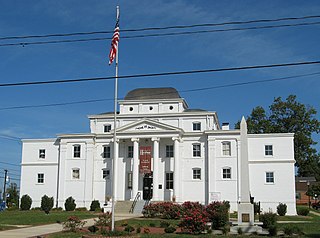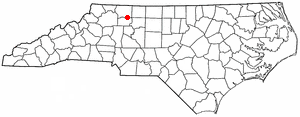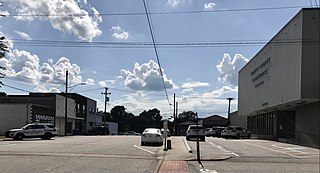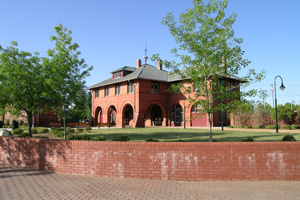
Davidson County is a county located in the U.S. state of North Carolina. As of the 2020 census, the population was 168,930. Its county seat is Lexington, and its largest community is Thomasville.

Albemarle is a city in and the county seat of Stanly County, North Carolina, United States. The population was 16,432 in the 2020 census.

Wilkesboro is a town in and the county seat of Wilkes County, North Carolina, United States. The population was 3,687 at the 2020 census. The town is located along the south bank of the Yadkin River, directly opposite the town of North Wilkesboro. Wilkesboro is a Small Town Main Street community and has recently revitalized its historic downtown to include the Carolina West Wireless Community Commons, Wilkes Communications Pavilion, Heritage Square and Splash Pad. Cub Creek Park is adjacent to the downtown and contains many amenities, which include baseball, walking trails, mountain biking trails, trout fishing, dog park, basketball, tennis, and pickleball courts, picnic shelters, etc. Wilkesboro is also the home of the annual MerleFest, Carolina in the Fall, and Brushy Mountain Peach & Heritage festivals.

East Bend is a town in northeastern Yadkin County, North Carolina, United States. The population is 634 at the 2020 census. It is a Piedmont Triad community.

Yadkinville is a town in Yadkin County, North Carolina, United States. The population was 2,995 at the 2020 census. Located in the Piedmont Triad, it is the county seat and most populous city of Yadkin County.

Elkin is a town in Surry and Wilkes counties in the U.S. state of North Carolina, along the Yadkin River. Elkin shares its name with the surrounding township of Elkin Township. The population was 4,122 at the time of the 2020 census.
Yadkin College was a college founded in 1857 by the Methodist Protestant Church. It was located in rural Davidson County, North Carolina and named for the nearby Yadkin River. High Point University serves as the successor to Yadkin College.
Yadkin College is a census-designated place (CDP) in rural Davidson County, North Carolina, United States, located 9 miles (14 km) northwest of Lexington. Contrary to its name, it is not part of Yadkin County.
Gold Hill is an unincorporated community and census-designated place (CDP) in southeastern Rowan County, North Carolina, United States near the Cabarrus County line. It was first listed as a CDP in the 2020 census with a population of 372. It is situated near the Yadkin River and is served by U.S. Highway 52 and Old Beatty Ford Road.

Bonlee is an unincorporated community in western Chatham County, North Carolina, United States. It is located south of Siler City and north of Bear Creek along Old U.S. Route 421. Bonlee sits at an elevation of 518 feet (158 m). The community is home to several poultry feed mills and a K-8 school. The ZIP Code for Bonlee is 27213.

Rockford is an unincorporated community and former town in southern Surry County, North Carolina, United States.
Richmond Hill is an unincorporated community in northern Yadkin County, North Carolina, United States, along the Yadkin River. The community is on the Yadkin County side of the river between the Surry County communities of Rockford and Siloam. It is located in the Boonville ZIP code area (27011).

The Old Slave Mart is a building located at 6 Chalmers Street in Charleston, South Carolina that once housed an antebellum-period slave-auction gallery. Constructed in 1859, the building is believed to be the last extant slave auction facility in South Carolina. In 1975, the Old Slave Mart was added to the National Register of Historic Places for its role in Charleston's African American history. Today, the building houses the Old Slave Mart Museum.

This list includes properties and districts listed on the National Register of Historic Places in Yadkin County, North Carolina. Click the "Map of all coordinates" link to the right to view a Google map of all properties and districts with latitude and longitude coordinates in the table below.

Fort Defiance is a historic plantation house located near Lenoir, Caldwell County, North Carolina. The main block was built between 1788 and 1792, and is a two-story, frame structure measuring 28 feet by 40 feet. A wing was added in 1823. It was the home of Revolutionary War General William Lenoir. The property was transferred to the Caldwell County Historical Society in 1965 and operated as a historic house museum.

Cape Fear and Yadkin Valley Railway Passenger Depot is a historic train station located at 325 Franklin Street in Fayetteville, North Carolina. It was built in 1890 by the Cape Fear and Yadkin Valley Railway. It is a two-story brick passenger depot with a deep hip roof in the Romanesque Revival style. The seven bay by two bay building features a rounded brick arch arcade. It was listed on the National Register of Historic Places in 1983.
Yadkin College Historic District is a national historic district located at Yadkin College, Davidson County, North Carolina. The district encompasses 38 contributing buildings, 4 contributing sites, and 5 contributing structures in the village of Yadkin College. The contributing buildings include the 1856 Yadkin College building, one antebellum house, 11 houses built between about 1870 and 1890, and the Yadkin College Methodist Protestant Church (1886). The sites are the Yadkin College Cemetery, the site of the 1881 Yadkin College building, site of the Methodist Episcopal Church, and site of the post office, blacksmith shop and jail. The structures are traditional wells and corn cribs.

Rural Hall Depot is a historic train station located at Rural Hall, Forsyth County, North Carolina. It was built in 1888 for the Cape Fear and Yadkin Valley Railway. It is a one-story rectangular frame building sheathed in German siding. It measures 23 feet wide and 78 feet long. The interior consists of waiting rooms for white and "colored" passengers and a station master's office. Passenger service ceased in 1955, but the depot continued to provide services and facilities to freight trains until its closing in 1980. The building was moved to its present site in March 1980, and serves as a local railroad museum.
Morse and Wade Building, also known as the Yadkin Valley Hotel, is a historic commercial building located at East Bend, Yadkin County, North Carolina. It was built about 1890, and is a two-story, brick building on a brick foundation. It has Italianate style design elements including arched window and door openings. The building initially housed the Yadkin Valley Hotel in the east half and the Morse and Wade Store in the west half. From about 1903 to 1940, it housed a tobacco bag factory. It is the oldest known commercial building in East Bend.

Richmond Hill Law School is a historic home and law school building located near Richmond Hill, Yadkin County, North Carolina. It was built in 1848, and is a two-story, three-bay, "T"-plan, brick building. It has a low hipped roof and deep overhang. It was built as the home and law school of jurist Richmond Mumford Pearson.

















